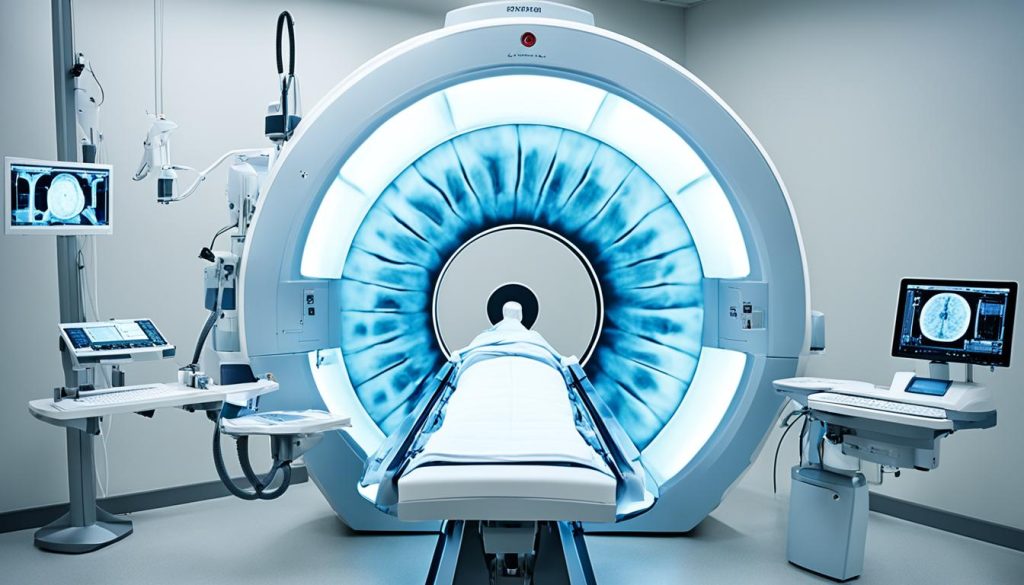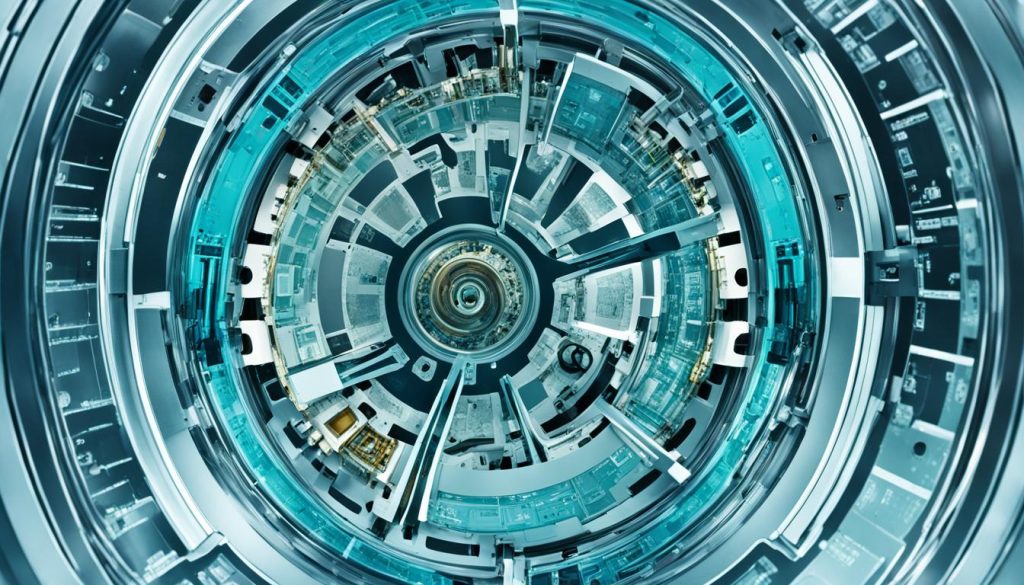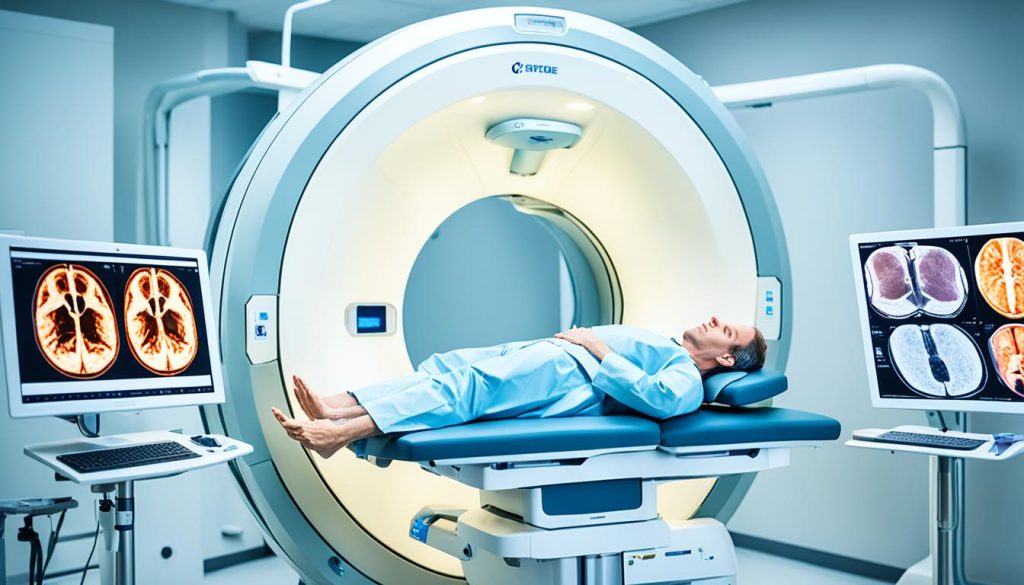Understanding Computed Tomography Basics
Computed Tomography (CT) is a vital tool in the field of medical imaging, providing physicians with detailed cross-sectional images of the human body. This advanced imaging technique utilizes X-ray technology and computer algorithms to create precise and high-resolution images, allowing for accurate diagnosis and monitoring of various conditions.
During a CT scan, the patient lies on a table that moves through a doughnut-shaped machine called the CT scanner. As the scanner rotates around the body, it emits X-ray beams that pass through the body’s tissues and are detected by sensors. These signals are then processed to generate detailed images that can be viewed on a computer screen.
CT imaging offers numerous advantages over other diagnostic imaging techniques. It provides clear visualization of soft tissues, bones, blood vessels, and organs, making it an invaluable tool in diagnosing conditions such as cancer, cardiovascular disease, and neurological disorders. Additionally, CT scans are non-invasive and typically require minimal preparation, making them a convenient and widely accessible imaging option for patients.

- Computed Tomography (CT) is a medical imaging technique that uses X-ray technology and computer algorithms to produce detailed cross-sectional images of the body.
- CT scans provide clear visualization of soft tissues, bones, blood vessels, and organs, facilitating accurate diagnosis and monitoring of various medical conditions.
- CT imaging offers advantages such as high resolution, non-invasiveness, and minimal patient preparation.
- CT scans are essential in diagnosing conditions like cancer, cardiovascular disease, and neurological disorders.
- Access to reliable CT services and selecting a reputable facility are crucial for accurate results and optimal patient care.
The Role of CT in Medical Imaging
Computed Tomography (CT) plays a crucial role in the field of medical imaging. By providing detailed cross-sectional images of the human body, CT scans offer invaluable insights for physicians in diagnosing and monitoring various conditions.
Unlike other diagnostic imaging techniques, CT imaging offers exceptional advantages. Its ability to capture high-resolution images enables healthcare professionals to visualize internal structures with clarity and precision. This aids in the accurate identification of abnormalities and assists in developing effective treatment plans.
Furthermore, CT technology has revolutionized medical imaging by allowing for three-dimensional reconstructions of the scanned area. This enables medical professionals to examine a patient’s anatomy from multiple angles, facilitating comprehensive analysis and supporting informed decision-making.
The Advantages of CT Imaging:
- Provides detailed cross-sectional images
- Offers high-resolution imaging
- Enables three-dimensional reconstructions
- Supports accurate diagnosis and treatment planning
- Allows for comprehensive analysis from multiple angles

| Advantages of CT Imaging | Advantages of Other Diagnostic Imaging Techniques |
|---|---|
| High-resolution images | Applicable for various medical conditions |
| Ability to visualize internal structures with clarity | Non-invasive imaging |
| Three-dimensional reconstructions | Minimal radiation exposure |
| Accurate identification of abnormalities | Real-time imaging |
Understanding the CT Procedure
In this section, we will provide an overview of the CT procedure, guiding you through what to expect during the process. Whether you’re scheduled for a CT scan or considering it as a diagnostic option, understanding the procedure’s ins and outs can alleviate any concerns and ensure a smooth experience.
Preparation
Prior to your CT scan, the healthcare provider may provide specific instructions to help you prepare. This may include fasting for a few hours before the procedure, avoiding certain medications, or removing any clothing or accessories that could interfere with the imaging process. It’s crucial to follow these guidelines to obtain the most accurate results.
During the Scan
Once you’re prepared, you will be positioned on a movable table that slides into the CT machine. The scanner may rotate around your body, capturing multiple X-ray images from different angles. During the scan, it’s important to remain still, as any movement can affect the clarity of the images. You might hear slight buzzing or clicking noises, which are normal parts of the scanning process.
Aftercare
After the scan is complete, you will be able to resume your normal activities immediately. There is typically no downtime or recovery period required. The healthcare provider will review the images and provide the necessary follow-up based on the findings. If intravenous contrast dye was used during the scan, you might be advised to drink plenty of fluids to help flush it out of your system.
CT Services and Testing
CT services are widely available at reputable medical facilities. These services encompass a range of CT examinations, each tailored to specific areas of the body or medical conditions. Some common types of CT testing include:
- Chest CT scan
- Abdominal CT scan
- Pelvic CT scan
- Head CT scan
- Sinuses CT scan
- Spine CT scan
Choosing a trusted facility for your CT testing is essential for accurate results and expert interpretation. Consider factors such as the facility’s reputation, experience of the radiologists, and the quality of imaging equipment to ensure you receive the best possible care.

Conclusion
In conclusion, Computed Tomography (CT) is a crucial tool in medical imaging, playing a vital role in diagnostic clarity and precision for patient care. CT scans, with their ability to provide detailed cross-sectional images of the human body, aid physicians in accurately diagnosing and monitoring various conditions.
With the help of state-of-the-art CT technology, medical professionals can obtain high-resolution images that offer invaluable insight into the human anatomy. This technology, combined with the expertise of skilled radiologists and technicians, ensures accurate and reliable results.
It is important to select reputable CT services that prioritize patient care and adhere to strict quality standards. By understanding the fundamentals of Computed Tomography (CT) and its role in medical imaging, individuals can appreciate the potential benefits and applications of this advanced technology in modern medicine.
FAQ
What is Computed Tomography (CT) imaging?
Computed Tomography, also known as a CT scan, is a medical imaging technique that uses specialized X-ray equipment to generate detailed cross-sectional images of the body. CT imaging produces highly detailed images, allowing physicians to diagnose and monitor various medical conditions.
How does CT technology work?
CT technology utilizes a rotating X-ray tube and detectors to capture multiple X-ray images at different angles around the body. These images are then processed by a computer to create cross-sectional images, called slices, which can be further reconstructed to visualize structures and tissues from different perspectives.
What are the uses of CT imaging?
CT imaging is employed in a wide range of diagnostic applications, including evaluating injuries to the head, spine, or other skeletal regions, detecting cancer and tumors, assessing the extent of organ damage or disease progression, and guiding minimally invasive procedures such as biopsies or needle aspirations.
Is a CT scan procedure safe?
CT scans are generally considered safe. However, they do involve exposure to X-ray radiation. The benefits of obtaining essential diagnostic information often outweigh the risks associated with radiation exposure. Modern CT machines are designed to minimize radiation dose while maintaining image quality. It is important to inform your healthcare provider about any existing conditions or concerns you may have before undergoing a CT scan.
How long does a CT scan procedure take?
The duration of a CT scan procedure can vary depending on the area being imaged and the complexity of the examination. Generally, a CT scan takes about 5 to 20 minutes, including setup time and image acquisition. However, certain specialized scans may take longer.
Are there any specific preparations required before a CT scan?
Preparation instructions may vary depending on the specific CT scan being performed. In some cases, you may be asked to avoid eating or drinking for a certain period before the scan. It is essential to follow any instructions provided by your healthcare provider to ensure the best possible imaging results.
Will I experience any discomfort during a CT scan?
CT scans are generally painless. During the procedure, you will be asked to lie still on a moving table that will slide through the CT machine. You may need to hold your breath briefly to minimize any motion artifacts in the images. The machine may emit slight buzzing or whirring sounds as it operates.
How soon will I receive my CT scan results?
After your CT scan, the images will be reviewed and interpreted by a radiologist, who will generate a detailed report. The timing of receiving your results may vary depending on the healthcare facility’s protocols and the urgency of the situation. Your healthcare provider will discuss the timing of follow-up appointments or discussions regarding the results with you.
How can I find reputable CT services?
To find reputable CT services, you can start by asking your healthcare provider for recommendations. They can direct you to facilities with experienced radiologists and state-of-the-art equipment. You can also research local medical facilities, checking for accreditations and reading patient reviews to ensure the quality and reliability of the CT services provided.